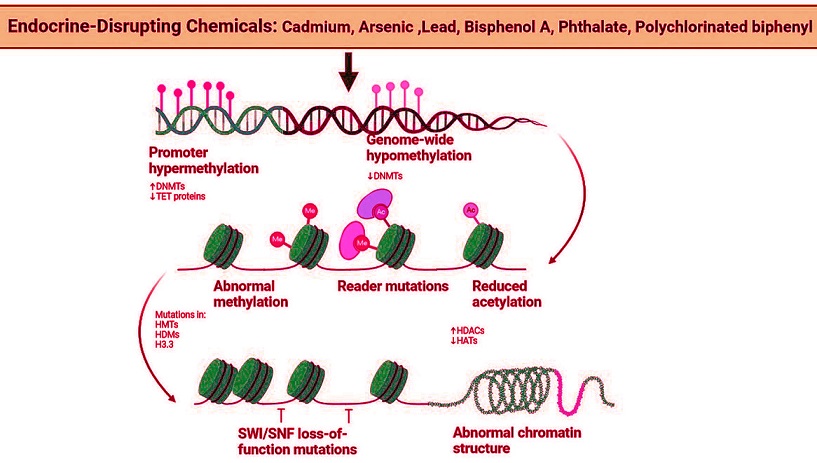Nikhil Prasad Fact checked by:Thailand Medical News Team Jan 02, 2025 3 months, 1 week, 4 days, 6 hours, 50 minutes ago
Medical News: The global fight against breast cancer has taken an alarming turn with new research revealing how endocrine-disrupting chemicals (EDCs) influence epigenetics and increase the risk of breast cancer. The findings provide critical insights into the molecular pathways through which these environmental pollutants disrupt normal cell function. Scientists from the Amity Institute of Biotechnology at Amity University Rajasthan-India have delved deeply into this issue, uncovering a complex interplay between EDCs and epigenetic mechanisms.
 Endocrine disruptors and risk factors mediate epigenome modifications that increase the risk of breast cancer. EDC may prolong puberty and increase mammary epithelial cell proliferation, allowing for a longer duration or faster rate of epigenetic remodelling of the developing mammary gland, resulting in chromatin destabilisation, mispackaging of genes in active/inactive domains, and aberrant expression of genes in key regulatory pathways. Mutations in HMTs (histone methyltransferases), HDMs (histone methyltransferases), and H3.3 (Histone variant H3.3) increase Histone deacetylase 1 (HDAC1) but reduce HATs (histone acetyltransferases)
Breast Cancer and the Role of Epigenetics
Endocrine disruptors and risk factors mediate epigenome modifications that increase the risk of breast cancer. EDC may prolong puberty and increase mammary epithelial cell proliferation, allowing for a longer duration or faster rate of epigenetic remodelling of the developing mammary gland, resulting in chromatin destabilisation, mispackaging of genes in active/inactive domains, and aberrant expression of genes in key regulatory pathways. Mutations in HMTs (histone methyltransferases), HDMs (histone methyltransferases), and H3.3 (Histone variant H3.3) increase Histone deacetylase 1 (HDAC1) but reduce HATs (histone acetyltransferases)
Breast Cancer and the Role of Epigenetics
Breast cancer remains one of the leading causes of cancer-related deaths worldwide. Despite advancements in early detection and treatment, many unanswered questions surround the risk factors that predispose individuals to this disease. This
Medical News report explores how endocrine-disrupting chemicals - exogenous molecules that interfere with the hormonal systems - play a pivotal role in altering gene expression without modifying the underlying DNA sequence.
These chemicals, including cadmium, bisphenol A (BPA), phthalates, and parabens, disrupt crucial processes such as DNA methylation, histone modifications, and microRNA expression. The study highlights how exposure to these chemicals - whether through food, household products, or industrial environments - can cause significant harm to breast tissues.
Key Findings on EDCs and Breast Cancer
The research identifies specific EDCs and their molecular impacts:
-Cadmium: Found naturally in the Earth's crust and often inhaled through tobacco smoke, cadmium can influence DNA methylation and histone modification. It affects key signaling pathways like NF-κB and MAPK, leading to increased cellular proliferation and decreased apoptosis. These disruptions promote tumor progression.
-Bisphenol A (BPA): Commonly used in plastics and thermal paper, BPA mimics estrogen and alters the epigenetic landscape. By inducing hypermethylation of genes like BRCA1, BPA exacerbates breast cancer risks, especially in estrogen-receptor-positive tumors. It also activates signaling pathways such as ERK1/2, which further fuels tumor growth.
-Phthalates: Widely used as plast
icizers, phthalates affect gene expression by altering DNA methylation and influencing long non-coding RNAs (lncRNAs). This disruption interferes with estrogen and progesterone signaling pathways, increasing the likelihood of malignancies.
-Parabens: Found in personal care products, parabens mimic estrogen and induce aberrant DNA methylation. This results in silencing of tumor suppressor genes, further contributing to breast cancer risk.
-Polychlorinated Biphenyls (PCBs): Although banned in many countries, these chemicals persist in the environment. PCBs interfere with calcium signaling and induce oxidative stress, leading to DNA damage and epigenetic alterations that promote cancer.
Mechanisms of Epigenetic Disruption
The study details several mechanisms through which EDCs impact the epigenome:
-DNA Methylation: EDCs can add or remove methyl groups to DNA, altering gene expression. For example, cadmium-induced methylation represses tumor suppressor genes, while BPA hypermethylates genes like BRCA1, increasing susceptibility to cancer.
-Histone Modifications: EDCs can modify histones, the proteins around which DNA is wound. This alters chromatin structure and affects the accessibility of genes for transcription. For instance, lead and BPA have been shown to impact histone acetylation and methylation, leading to aberrant gene expression.
-MicroRNA Expression: EDCs can dysregulate microRNAs (miRNAs), which are crucial for regulating gene expression. For example, arsenic exposure suppresses miR-182-5p, which plays a role in cellular proliferation and differentiation.
Long-Term Health Implications
The research highlights that exposure to EDCs often begins early, even in utero, and can have lasting effects on the developing mammary glands. Prolonged exposure disrupts hormonal signaling and increases the susceptibility of breast tissues to cancer. This underscores the urgent need for stricter regulations and public awareness campaigns to limit exposure to these harmful chemicals.
Conclusions and Future Directions
Understanding the epigenetic impacts of endocrine-disrupting chemicals is critical for developing new strategies to combat breast cancer. The study provides compelling evidence that these chemicals - ubiquitous in our environment - alter genetic expression through epigenetic modifications, thereby increasing cancer risk. It calls for multidisciplinary approaches involving scientists, policymakers, and healthcare professionals to mitigate the harmful effects of EDCs.
Future research should focus on identifying biomarkers for early detection of EDC exposure and breast cancer risk. Public health initiatives must prioritize reducing exposure to these chemicals, particularly in vulnerable populations.
The study findings were published in the peer-reviewed Journal of Xenobiotics.
https://www.mdpi.com/2039-4713/15/1/1
For the latest on Breast Cancer, keep on logging to Thailand
Medical News.
Read Also:
https://www.thailandmedical.news/news/study-shows-hair-dyes-and-hair-straightening-chemical-treatments-increases-breast-cancer-risk
https://www.thailandmedical.news/news/harvard-study-shows-no-link-between-personal-use-of-permanent-hair-dyes-and-cancers-or-cancer-mortality-in-women
https://www.thailandmedical.news/articles/cancer
